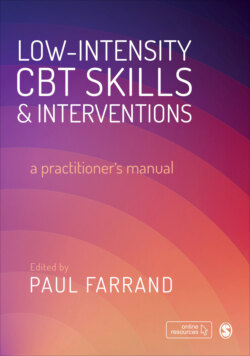Читать книгу Low-intensity CBT Skills and Interventions - Группа авторов - Страница 10
На сайте Литреса книга снята с продажи.
ОглавлениеIntroduction: Pedagogic Approach
Paul Farrand
The pedagogic approach adopted within Low-Intensity CBT Skills and Interventions has been organised and informed by the seminal work of Professor James Bennett-Levy. Professor Bennett-Levy's research has made a significant contribution to evidence-informed training for the psychological therapies workforce and has no doubt contributed to improving the effectiveness of cognitive behavioural therapy (CBT) in practice.
Cognitive Model of Skills Development
The Cognitive Model of Skills Development (Bennett-Levy, 2006) highlights the role of three systems – Declarative, Procedural, Reflective (DPR) – associated with competency development.
Declarative Knowledge
‘Knowing that’ represents factual knowledge the low-intensity CBT (LICBT) practitioner has regarding:common factors that form the basis of the clinical methodspecific factors representing the theoretical foundation and specific competences upon which the LICBT clinical method and interventions are based.
It is predominantly delivered using didactic pedagogic approaches such as lectures, clinical skills supervision and directed-learning activities such as reading.
There are increasing opportunities to deliver declarative knowledge through online technology-enhanced learning methods within a blended learning approach (Graham, 2006).
It presents opportunities to inform a component of university-directed or self-directed learning incorporated into standardised delivery.
Procedural Knowledge
‘Knowing how to, and when to’ apply specific factor skills associated with the clinical method (see Parts 2 and 3).
Although there may be a declarative element to procedural knowledge, pedagogic approaches that facilitate the transfer of declarative to procedural knowledge are required. Active pedagogic approaches include simulated structured role-plays, directly observed or recorded specific factor practice and clinical skills supervision of live patient clinical sessions.
Development of procedural knowledge is ongoing.
It is stimulated when the practitioner is required to apply already acquired procedural skills to newly experienced clinical challenges or adapt practice to accommodate patients with diversity.
Developing procedural knowledge is often implicit, with practitioners not fully aware of the application of common or specific factors.
Training providers and supervisors need to ensure that pedagogic approaches supporting the development of specific factors have an element of observation. This may require training providers to ensure an appropriate staff–student ratio to enable trainees get an appropriate level of feedback.
Reflection is the key system for facilitating ongoing competence development required for professional expertise.
Reflection
Making the implicit explicit enables the implicit nature of the development of procedural knowledge to be made explicit (Bennett-Levy, 2003).
Ongoing reflective practice has a seminal role in distinguishing expert from novice practitioners (Skovholt and Rønnestad, 2001).
There is additional potential to enhance practitioner resiliency (Skovholt and Rønnestad, 2001) and further opportunities for reflection in LICBT with the provision of case management alongside clinical skills supervision (Farrand et al., 2016).
Reflective questions are used throughout each chapter to stimulate personal reflection on salient, and at times, challenging points.
Closing the Gap between the DPR systems
Self-practice/self-reflection (SP/SR; Bennett-Levy et al., 2001) offers effective ways to close the gap between the three systems associated with the DPR model. The focus of SP/SR, including reflection on the personal self, enables trainees to learn from the application of procedural skills whilst reflecting on any personal impact that skills application may have on them. This enables trainees to more effectively put themselves in the patients’ shoes, facilitating competency development by enabling them to anticipate challenges when directly experiencing specific factors associated with the LICBT clinical method. Tools such as blogs to support written reflections following self-practice have been used to enable trainers to address commonly occurring themes or share reflections as the basis of classroom discussion (Farrand et al., 2010). This approach can be particularly helpful when the delivery of training includes university-directed or self-directed learning components.
Assessing Your Understanding
An ‘Assessing Your Understanding’ section is included at the end of each chapter to help you appreciate your understanding of declarative knowledge and continue to develop procedural competency. Multiple-choice, extended-matching or essay questions and case studies are included at the end of each chapter to enable you to assess your declarative knowledge. These are supplemented by SP/SR activities to help you continue to develop clinical competency during, or following, training, to stimulate continuing professional development and facilitate the transition from novice to expert (Bennett-Levy et al., 2009). Reflection points included within each chapter are included to stimulate reflection on key areas.
